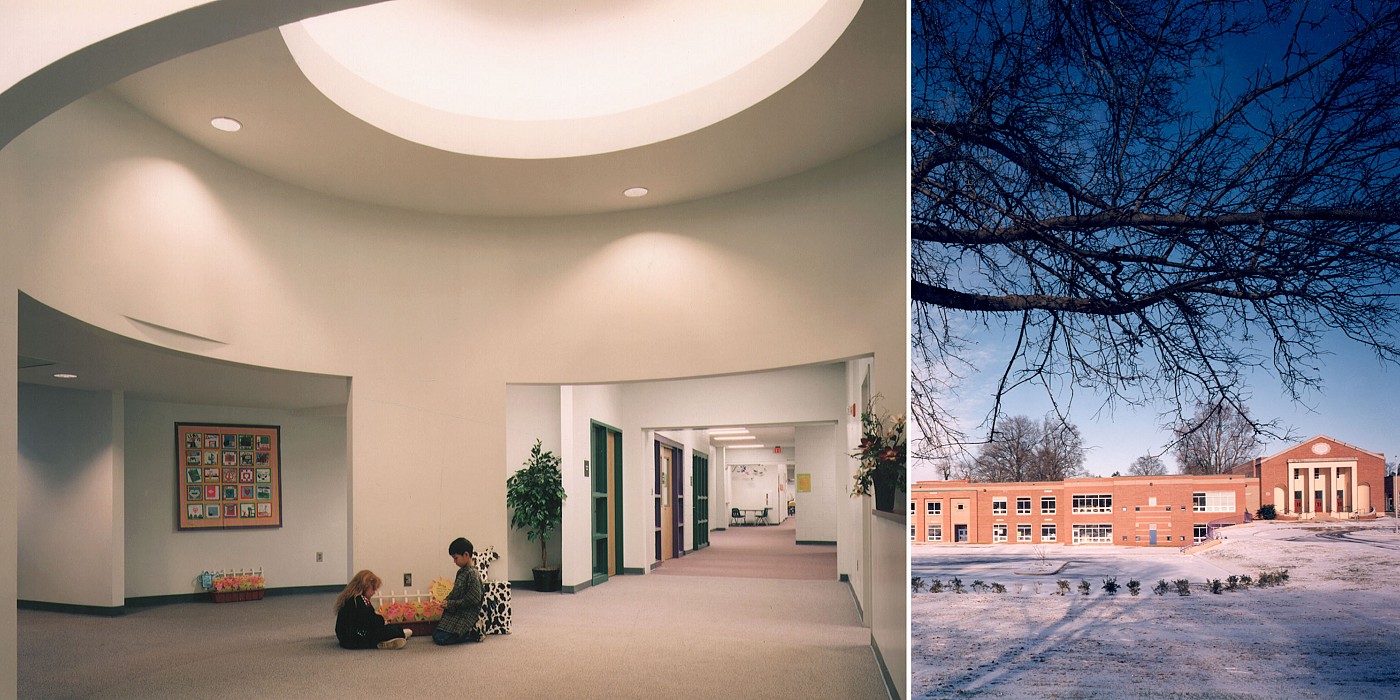- You have not saved any projects.
Irwin Avenue Open Elementary School
Irwin Avenue Open Elementary is a special school within the Charlotte-Mecklenburg Schools (CMS) system. Built around 20-year open education program (Irwin is not an open plan school!) the new school is the result of the reuse of an historic campus and the persistence of a very involved parent, teacher and volunteer community.






Shook Kelley employed an extensive participatory design process involving parents, teachers, staff, students and UNCC School of Education faculty to develop a program and design uniquely suited to this curriculum.
By application of a very thorough workshop process, a highly tailored yet flexible school within the stringent budget established by CMS was delivered.
Shook Kelley’s Needs Assessment of this 1930s school concluded that due to functional obsolescence and structural inadequacy the school should be replaced. However, we were able to creatively retain two significant portions of the building. The Gymnasium, located at the west end of the school, was retained as an economical way to provide better recreational facilities than a new Elementary School would usually have. This gym is also used as a community resource. The original school Auditorium was retained for its historic significance as the location of the integration of Charlotte Schools. The space had long been converted from an auditorium into other uses. It was re-purposed to serve as the new school’s main entrance and the administrative offices for the school.
The design of the individual classroom generated over 15 different options to arrive at the desired arrangement of the learning areas within the classroom. A full scale mockup of the design was built in the Gym so students and teachers could “test drive” their new space. Multiple “hands on” learning centers were developed and designed throughout the school under the guiding principal of “All places as Learning Spaces.”
The building was designed for a NCDPI pilot program for energy efficiency years before LEED, green or sustainable design had entered the educational design vocabulary. Features included: High efficiency mechanical systems beyond code and accepted norm for that time; Daylighting of interior learning spaces through the use of roof monitors; Classroom lighting controls with daylight and occupancy sensors; and the reuse of the existing gymnasium and historic auditorium from the original 1939 Harding High School.
The process also delivered a very happy client. Teachers and administrators alike rave about Irwin. To them, Irwin is truly “their” school, an educational environment which they designed. Irwin won a Citation Award given jointly by the American Association of School Administrators (AASA), the American Institute of Architects (AIA), and the Council of Educational Facility Planners, International (CEFPI).
Shook Kelley employed an extensive participatory design process involving parents, teachers, staff, students and UNCC School of Education faculty to develop a program and design uniquely suited to this curriculum.
By application of a very thorough workshop process, a highly tailored yet flexible school within the stringent budget established by CMS was delivered.
Shook Kelley’s Needs Assessment of this 1930s school concluded that due to functional obsolescence and structural inadequacy the school should be replaced. However, we were able to creatively retain two significant portions of the building. The Gymnasium, located at the west end of the school, was retained as an economical way to provide better recreational facilities than a new Elementary School would usually have. This gym is also used as a community resource. The original school Auditorium was retained for its historic significance as the location of the integration of Charlotte Schools. The space had long been converted from an auditorium into other uses. It was re-purposed to serve as the new school’s main entrance and the administrative offices for the school.
The design of the individual classroom generated over 15 different options to arrive at the desired arrangement of the learning areas within the classroom. A full scale mockup of the design was built in the Gym so students and teachers could “test drive” their new space. Multiple “hands on” learning centers were developed and designed throughout the school under the guiding principal of “All places as Learning Spaces.”
The building was designed for a NCDPI pilot program for energy efficiency years before LEED, green or sustainable design had entered the educational design vocabulary. Features included: High efficiency mechanical systems beyond code and accepted norm for that time; Daylighting of interior learning spaces through the use of roof monitors; Classroom lighting controls with daylight and occupancy sensors; and the reuse of the existing gymnasium and historic auditorium from the original 1939 Harding High School.
The process also delivered a very happy client. Teachers and administrators alike rave about Irwin. To them, Irwin is truly “their” school, an educational environment which they designed. Irwin won a Citation Award given jointly by the American Association of School Administrators (AASA), the American Institute of Architects (AIA), and the Council of Educational Facility Planners, International (CEFPI).